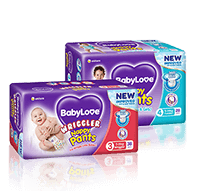Curious Toddlers Back
Toilet Training
Being toilet trained is a big milestone for your baby’s development. Find out the signs indicating toilet training readiness and how you can assist your baby.
Signs of readiness
| Understanding the Signs | Baby’s Toilet Training | |
| a. | Child is able to understand simple directions like pulling up pants, walking to bathroom. Child is able to sit for 2-5 minutes at a time. | Set an example either from yourself, brothers and sisters or even neighbour’s children if need be. |
| b. | Child remains dry for a few hours. | Encourage child to understand signs of bowel movement and what to do when it occurs. |
| c. | Child is not comfortable in soiled or wet diaper. | Ask child regularly to instil awareness and readiness at all times. Gentle reminders at regular intervals. |
| d. | Child understands and shows signs of bowel movement like grunting or squatting. | Use easy-to-understand and positive words like pee pee & poo poo to further encourage child rather than words that promote negative perception. |
| e. | Child shows interest towards using toilet bowl. | Familiarise your child with putting their pants on and off on their own. |
| f. | Child is not comfortable with sitting on a potty chair. | Provide a sturdy yet comfortable potty chair and train your child to use it properly. |
| g. | Child is done with the potty and stands up. | Teach child to help lean after themselves after each potty session in a fun and healthy way! You will need to wipe their bottoms for them initially. Teach child to wash hands after. |
Handling Toilet Training Issues
You might face several issues when toilet training your child. Try some of these tips to manage it:
| Resistance | Daytime Bladder Control | Nighttime Bladder Control | |
| a. | Do not worry if your child seems to resist the use of potty chair, they might be uncomfortable or not be ready. Don’t force them. Leave until they are willing to try again. | Daytime control of your baby’s bladder is more manageable and can be induced through proper training and monitoring. | Nighttime bladder control is involuntary and may take up to several months to several years after your child is able to master nighttime bladder. |
| b. | Try to understand and overcome the issues instead of forcing which could deter baby even longer. | Train your baby to inform you when it is time to go. | Continue using diaper at night as your baby might not be able to control their bladder until maturity or schooling age. |
| c. | Baby’s age and mental readiness could also be a factor. Needs to be between 8 months – 3 years old before they are mature enough to recognise the urge to go to the toilet. | Alternatively train your baby on a schedule to foster habit. | Parents will have to be patient and help their baby develop their state of mind. |
| d. | Promote rewards and praises instead of scolding and punishment. | Let your baby take charge and set the pace on their own. | Try to promote habits like urinating and drinking less water before going to bed. |
| f. | Baby is not comfortable with sitting on a potty chair. | Provide a sturdy yet comfortable potty chair and train your baby to use it properly. | |
| g. | Baby is done with the potty and stands up. | Teach baby to clean after themselves after each potty session in a fun and healthy way! |
Tips:
- Expect accidents: using the toilet will take practice.
- Give child praise for trying even if they wet themselves.
- Try not to get angry. Be relaxed about accidents. Stay calm and positive.




